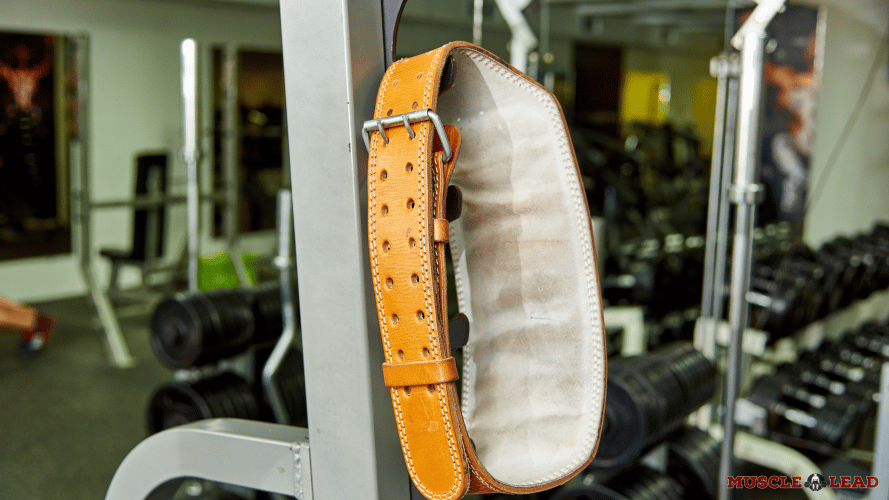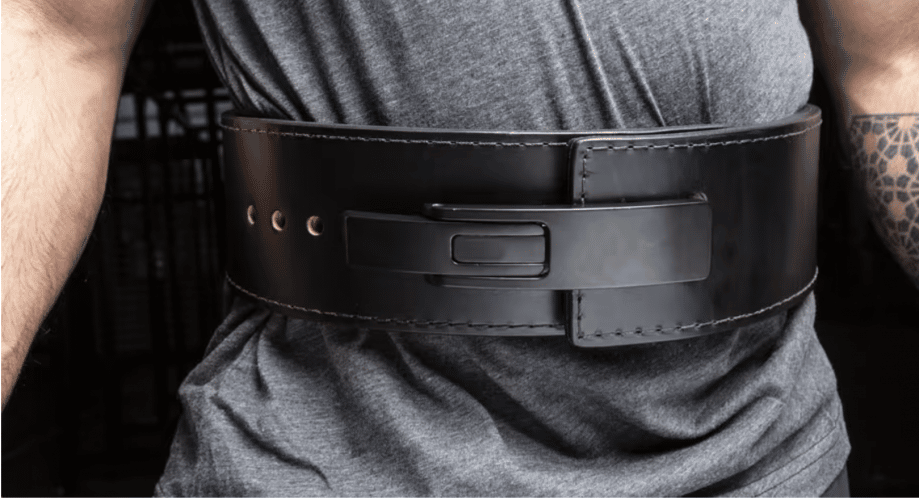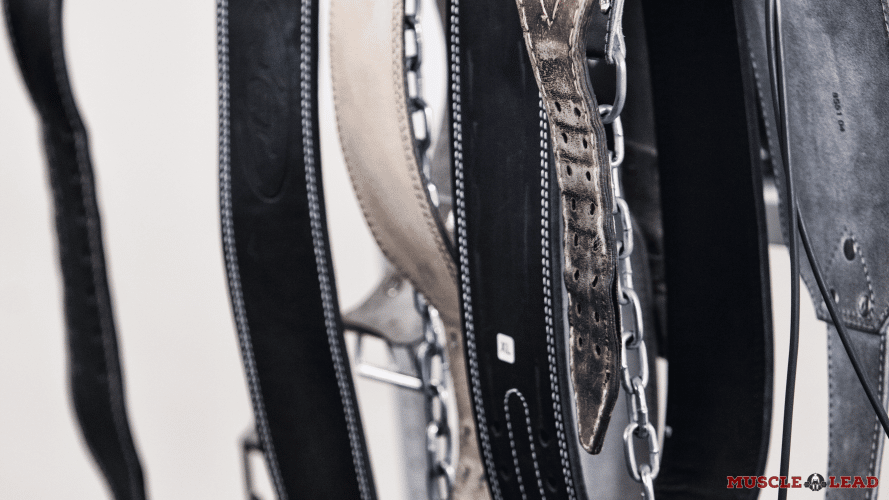Key Differences
- The main difference is the belt locking mechanism. Lever belts use a lever for securing, while prong belts use prongs.
- The lever system allows you to set the belt wherever you feel comfortable. While you can tighten the prong belt according to the holes on the belt.
- Prong belts are cheaper as compared to lever belts. Lever belts also tend to have a longer life span depending on how rough you use yours.
There comes a time in the life of every lifter when he/she considers buying a lifting belt.
It’s the next logical step in the progression towards heavy lifting. No reputable athlete shies away from making this purchase.
And, do you know what? They’re absolutely right about this decision.
So what are the differences between a lever vs prong belt? A lever belt is more expensive but it secures in a smooth fastening motion. The prong belt is cheaper and can be difficult to fasten but you can better adjust the tightness. So for certain lifts, you can choose different holes to adjust your prongs. Overall, both belts serve the same purpose and offer excellent support.
Now that we have a general sense of the differences, let’s get into more detail for each of them.
In a Hurry? Here’s My Recommendation
Both lever and prong belts offer the same level of support but I recommend the lever belt for intermediate to advanced lifters.
The best 4-inch powerlifting belt on the market is the Inzer Forever Lever belt by IAD. Many powerlifters swear by this belt, and it comes with a lifetime replacement warranty.
A Top Choice For Powerlifters
Considered to be the standard in lifting belts, the Inzer Forever Belt comes with a lifetime guarantee. At 10mm and 4-inch width, its superb build quality and material make it ideal for all types of lifters.
If you’re a beginner wanting to get a belt for teaching you the mechanics and technique, a prong belt would be better.
What is the Difference Between a Lever and Prong Belt?
The distinction between these two types of belts is right there in the name: lever belts use a lever for securing, while prong belts use prongs.
This small difference actually plays a vital role, once you think about the specific exercises that you will be performing in the gym.
How to choose the right one for you? Read through my examples of the advantages and disadvantages in use, and see which one better fits your individual needs.
Let’s get into all of that.
Lever Belt vs Prong Belt – 6 Key Differences
1. Construction Quality
This first point is a general recommendation. A lifting belt should be a one-time investment. This will mean a larger upfront cost, but a better yield of quality over the years. The construction quality of the belt varies not from type to type, but from one producer to the other.
That being said, the type of belt that you decide on, should be bought from a reputable producer on the market. I would recommend scanning through customer reviews, testimonials, and how popular the producer is in the fitness world.

If you do not make the purchase with this aspect in mind, you are looking at a costly replacement and a rather unpleasant experience of belt rupture in the future. Not ideal in my opinion.
Once the quality aspect is out of the way, it is time to differentiate between the types of belts.
Nylon vs Leather Lifting Belt – Which is the Best?
2. Lifting Belt Security
Winner: Lever Belt
When talking about security, I refer to the ease at which a lifter can tighten the belt around the waist. We have two mechanisms to compare: the lever vs the prong.
From my point of view, the lever proves to be much easier to secure than the prong. The reason is, the prong has a set of holes that are premade, and cannot be modified by the lifter.
Does this sound like a deal-breaker? Probably not, but when you think about the many instances in which you would have to do this, it does seem that the lever is an easier option.
The mechanics are quite straightforward in that case, and the tightness of the belts has virtually no difference. I would personally go with the lever from this point of view.
Single Prong Vs Double Prong Lifting Belt – Which One is Best for You?
What I would stay away from are belts with two prongs. I have tried some of these in my days, and found that the second hole is almost impossible to secure, and it offers no benefit whatsoever. Two prongs are definitely not better than one.

3. Tightness
Winner: Lever Belt
Lifting belts have to be tightened in order to be effective. That’s an indispensable truth.
But there is a “sweet spot” for every lifter, where the best performance is achieved. Does one belt allow you to reach this “sweet spot” better than the other?
In my opinion, YES! And it’s the lever belt.
This does not go to say that prong belts are impossible to use comfortably, but the hole buckle system gives you limited options to choose from. If your “sweet spot” happens to be somewhere between two holes, tough luck.
Moreover, this buckle system may even force you to go beyond this comfort zone, where the tightness starts messing with your breathing and makes exercises harder to perform.
This does not happen with the lever belt. The lever system allows you to set the belt wherever you feel comfortable, thus making it a whole lot easier to get more optimal performance.
So, this round of comparison definitely has a victor, THE LEVER BELT!
4. Size Adjustment
Winner: Prong Belt
If you agree that the lever belt took the cake in the last category, it may fall short in the case of adjustability.
Adjustment of size is much easier with the prong belt.
Why so?
The buckle system of the prong is much easier to change in a couple of seconds, which is useful under certain circumstances.
For example, If you have just finished a meal before lifting, you will not want as much tightness around the waist as per usual.
However, In the case of the lever belt, you will need a screwdriver to take care of the tightness, unscrew the lever, move the belt up or down, then screw it back in. This will take you a good 5 minutes. Not the best scenario.
But are there really that many instances in which it is necessary to adjust the size? Not necessarily, if you make the effort to maintain the regularity of variables like meal timing and the thickness of clothing.
Even with all that, you will still have to adjust to the differences between tightness in warm-up sets and the actual progressive training, so there isn’t really any escaping from that.
Prong belt wins in this category, hands down.
5. Price
Cheaper Option: Prong Belt
In terms of price, lever belts are not the most budget-friendly out there. They will imply an additional $20-$30 to what you would pay for a prong belt.
Now, this may be grounds for making a decision for some people, but in my opinion, what you should take into consideration is the implication that each system of securing has for you in the gym.
6. Lifespan and Longevity
Longer life: The lever belt slightly
Both lever and prong belts will last you for quite a long time in your lifting pursuits.
However, lever belts are known to have lifetime guarantees and many lifters never get new ones.
The top lever belt in the market made by Inzer, is well known throughout the lifting world as the only purchase you need.
Many prong belts can get a little worn naturally due to the mechanism of closure. Think of your regular clothing belt that gets bent and worn after several uses.

FAQs
Well, the keyword there is “preference” As I said in the beginning, both belts get the job done, in terms of optimizing spinal neutrality and performance. The difference that made me choose the lever is the ease of reaching the “sweet spot” of tightness, as I am not comfortable with middle grounds or bad measurements. I also don’t mind carrying a screwdriver around, it makes me seem more of a gym craftsman than I really am. The choice is up to you, after all.
Yes! As long as you make sure to use the equipment properly, you will mitigate the risk of spinal shrinkage, avoid injuries, and have better performance in the gym overall. This will happen both with the lever belt and the prong belt.
Final Thoughts
All in all, the 6 categories that I highlighted are what you need to have in mind before purchasing a lifting belt. If you shop in person, there is a chance that you will get to experiment with both models before making a decision, so do this if the possibility arises.
If not, think about what your gym experience looks like, or what you want it to look like in the future, and see which belt better fits the narrative.
References
- Lander, J.E., Simonton, R.L., Giacobbe., J.K.F. ‘The effectiveness of weight-belts during the squat exercise‘ Medicine & Science in Sports & Exercise. 1990; 22 (1): 117–126
- Bourne, N.D., &., Reilly. T. ‘Effect of a weightlifting belt on spinal shrinkage‘ British Journal of Sports Medicine. 1991; 25 (4): 209–212
More about Lifting Belts:







